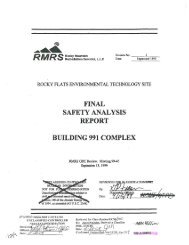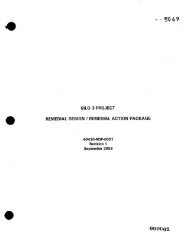ROCKY FLATS CITIZENS ADVISORY BOARD MINUTES OF WORK ...
ROCKY FLATS CITIZENS ADVISORY BOARD MINUTES OF WORK ...
ROCKY FLATS CITIZENS ADVISORY BOARD MINUTES OF WORK ...
You also want an ePaper? Increase the reach of your titles
YUMPU automatically turns print PDFs into web optimized ePapers that Google loves.
~<br />
,<br />
5/1/97 Meeting Minutes Page 3 of 10<br />
sitewide monitoring, Industrial Area monitoring, Industrial Area discharge to ponds,<br />
water leaving the site, and offsite community monitoring.<br />
Groundwater monitoring: The goals/purpose are to comply with regulations, to<br />
protect surface water, and to reduce risks to the public and the environment. The data<br />
is used to identify potential contaminants and sources, identify contaminant<br />
pathways, monitor contaminant concentrations, monitor contaminants plume<br />
migration, monitor impacts from remediation and D&D activities, and evaluate<br />
contaminated groundwater impact to surface water. Contaminants and parameters<br />
monitored are radiological, non-radiological, and hydrological characteristics. There<br />
are 262 monitoring wells; all 262 wells measure water level, and 89 of these are<br />
sampled and analyzed for contaminants. Those 89 wells encompass six groundwater<br />
well networks.<br />
Ecological monitoring: The goals/purpose of the program are regulatory compliance,<br />
to conserve the viability of existing ecosystems, to protect unique natural resources<br />
and special concern species, and to monitor negative ecosystem impacts from RFETS<br />
activities. Ecosystems which are monitored are vegetation communities (xeric<br />
tallgrass prairie, mesic mixed grassland, high quality grassland, tall upland<br />
shrublands, and riparian woodlands); and animal communities (such as the Preble's<br />
meadow jumping mouse). Sitewide monitoring activities are performed to study<br />
species richness, habitats and diversity, and to monitor noxious weeds. Project-<br />
specific monitoring is done to protect threatened and endangered species, and protect<br />
site wetlands.<br />
PHI'S next task is to begin writing a critical analysis of the programs listed above. CAB<br />
members, as well as those agencies participating in the research for this project, will be<br />
provided a chance for input into the report being prepared byPHI.<br />
Q&A / Comment Session:<br />
Air monitoring:<br />
Question: Susan Barron: Without a map, it's difficult to tell if there's overlap that's<br />
unnecessary.<br />
Answer: Dorothy Hall: There is some unnecessary monitoring, not much. Rocky Mountain<br />
has a redundant set of monitors. RFETS' primary meteorological station should be enough<br />
for that. Monitoring for VOCs at the fence line doesn't make a lot of sense. You need to be<br />
closer to the source. Some of the locations are excellent. Except for the reporting, the air<br />
monitoring system is good. There are problems with data gaps.<br />
Question: Susan Johnson: Is your project limited to ambient standards? Are you doing<br />
emissions monitoring?<br />
Answer: Dorothy Hall: Yes, the building emissions. We're just now getting information on<br />
that.<br />
Question: Susan Johnson: Would building effluent include a process emission?<br />
h ttp://ww w .rfcab.org/Minutes/5 - 1-97. html 3/7/2006

















